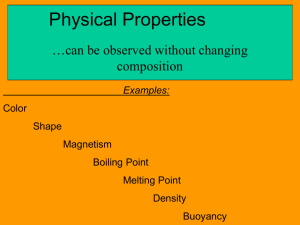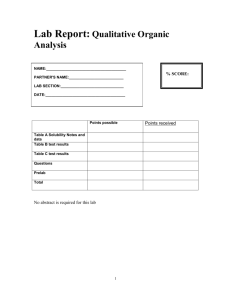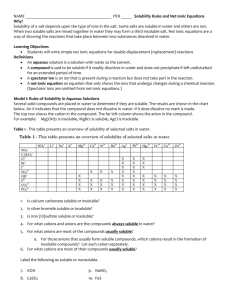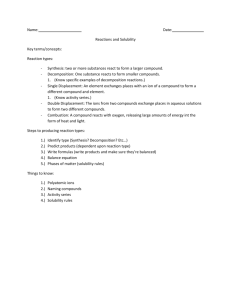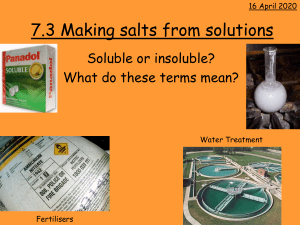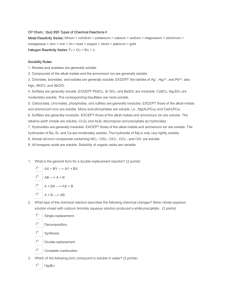Solubility Rules - South High School Library
advertisement
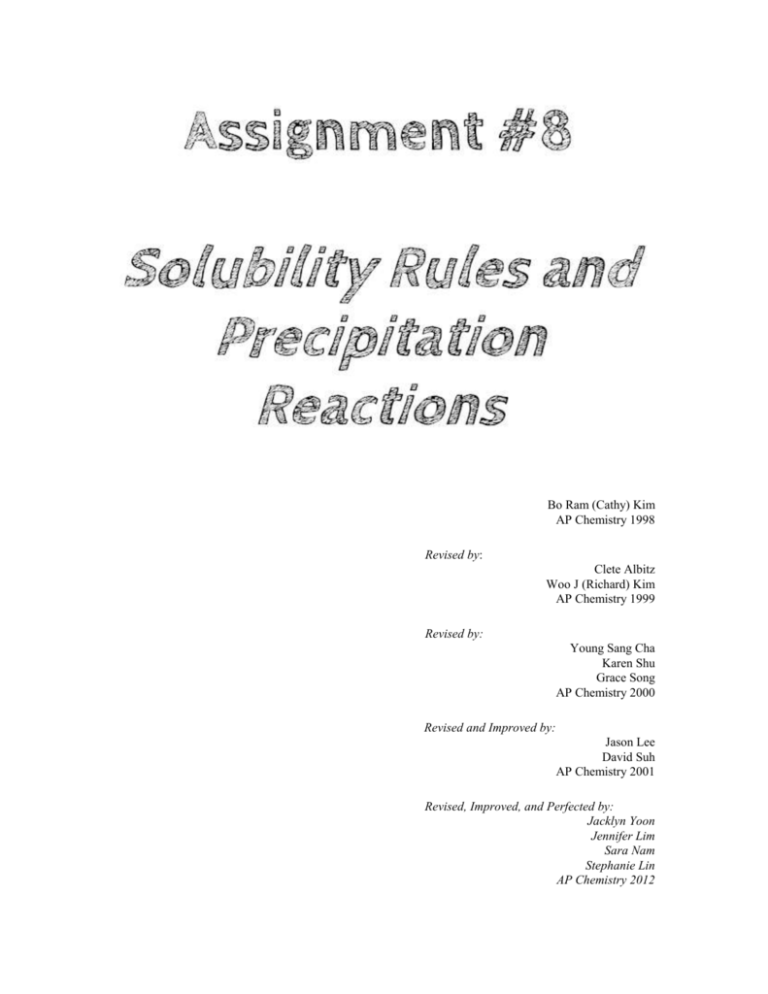
Bo Ram (Cathy) Kim AP Chemistry 1998 Revised by: Clete Albitz Woo J (Richard) Kim AP Chemistry 1999 Revised by: Young Sang Cha Karen Shu Grace Song AP Chemistry 2000 Revised and Improved by: Jason Lee David Suh AP Chemistry 2001 Revised, Improved, and Perfected by: Jacklyn Yoon Jennifer Lim Sara Nam Stephanie Lin AP Chemistry 2012 Solubility Rules The following rules are used in several chemistry-related topics, such as predicting reactions and quantitative analysis. You will learn these topics this year in AP Chemistry but if you don’t know your solubility rules, you’ll have a really hard time. Solubility rules must be committed to memory. No, seriously. You might even be tested on it later! Soluble Exceptions (Insoluble) + ammonium NH4 Potassium1 K+ Sodium1 Na+ nitrate NO3acetate C2H3O22 Chloride ClAg+, Hg2+2, Pb+2 sulfate SO4-2 Ba+2, Pb+2, Hg2+2, Ag+ chlorate ClO3 perchlorate ClO41 all Group I metals 2 Also, binary compounds of Br- and I- with metals are soluble. Exceptions are the same as with Chloride. Insoluble Hydroxide Oxide Phosphate Carbonate Sulfide Sulfite Silicate Silver - OH O-2 PO4-3 CO3-2 S-2 SO3-2 SiO3-2 Ag+ Exceptions (Soluble) *, Ba+2, Ca+2, Sr+2 *, Ba+2, Ca+2, Sr+2 * * * * * NO3* Group IA metals and NH4+ All strong acids and strong bases will ionize, or separate into its ions when reacting with water, completely. The only strong acids are: HCl, H2SO4, HClO4, HI, HBr, and HNO3. The strong bases are: NaOH, LiOH, KOH, Li2O. When you look at the solubility chart, you will notice that other bases, such as Ca(OH)2 and Ba(OH)2, are said to be soluble as well. However, except for the strong bases listed, all other bases are only SLIGHTLY soluble. Slightly soluble compounds mean that they will ionize only a little bit. To be safe, all bases, except for the strong bases listed above, should not be turned into its ions. Also if one part of a compound is soluble but the other isn’t, then the whole compound is insoluble. For example, in AgClO3, ClO3- is soluble but Ag+ is not. Therefore, the whole compound is insoluble. Precipitation Reactions Solubility Rules are critical in the field of reactions, especially precipitation reactions. A precipitation reaction occurs when two soluble salts are added, forming an insoluble salt (the precipitate) and a soluble salt. Soluble Salt + Soluble Salt Insoluble Salt + Soluble Salt For each of the following, write the reactions. (Note: If you have not already memorized all the Solubility Rules, go back and memorize them and then come back to this.) Separate the compounds into ions when they are soluble. Remember, strong acids and bases ionize completely; therefore they are separated into ions. Cross out common ions, which are also known as spectator ions. That’s the cool scientific term. Don’t forget to balance the equation. Ex: A solution of silver nitrate is added to a solution of potassium chloride. Molecular Equation: AgNO3 + KCl AgCl + KNO3 Molecular is basically what you get when you don’t ionize anything. Complete Ionic Equation: Ag+ + NO3- + K+ + Cl- AgCl + K+ + NO3Complete Ionic is when you ionize the compounds into their ions. Net-Ionic Equation: To get to the net-ionic form, cross out the spectator ions. Ag+ + NO3- + K+ + Cl- AgCl + K+ + NO3The answer will then be: Ag+ + Cl- AgCl This is the form that AP classes will usually take, unless specified. For this question, Silver chloride precipitates, or forms a solid because it does not ionize. Assignment #8 I. Soluble or Insoluble? Determine whether the following salts are soluble or insoluble. (Note: Try not to use your Solubility Rules chart. You will not be allowed to use the charts on your tests. So, try to learn and memorize the rules.) Ex. KCl Answer: soluble I. Solubility 1. NaOH 2. MgCl2 3. LiNO3 4. Al(NO3)3 5. NH4Cl 6. NaC2H3O2 7. (NH4)2S 8. Zn(OH)2 9. Ag2SO4 10. ZnS 11. Fe(OH)3 12. Pb(NO3)2 13. Na2CO3 14. KOH 15. AgCl 16. CaSO4 17. AgNO3 18. ZnCO3 19. KI 20. Hg2(C2H3O2)2 21. K2SO4 22. BaO 23. Ag3PO4 24. Ba(OH)2 25. Hg2Cl2 26. SnC2H3O2 27. SrO 28. Hg2SO4 29. BaCl2 30. Na2SiO3 II. Precipitation Reactions 1. A solution of silver nitrate is added to a solution of potassium bromide. 2. A solution of sodium carbonate is added to a solution of manganese (II) nitrate. 3. A solution of copper (II) nitrate is added to a solution of sodium carbonate. 4. A solution of calcium acetate is added to a solution of potassium fluoride. 5. A solution of lead (II) nitrate is added to a solution of potassium iodide. 6. A solution of barium chloride is added to a solution of sodium sulfate. 7. A solution of ammonium chloride is added to a solution of mercury (I) nitrate. 8. A solution of lithium acetate is added to a solution of iron (III) bromide. 9. A solution of zinc chloride is added to a solution of sodium hydroxide. 10. A solution of sodium hydroxide is added to a solution of iron (II) chloride. 11. A solution of silver nitrate is added to a solution of calcium chloride. 12. A solution of potassium phosphate is added to a solution of strontium sulfate. 13. A solution of potassium carbonate is added to a solution of zinc chloride. 14. A solution of copper (II) chloride is added to a solution of potassium sulfide. 15. A solution of lead (II) nitrate is added to a solution of lithium chloride. 16. A solution of sodium hydroxide is added to a solution of nickel (II) chloride. 17. Aqueous solutions of silver nitrate and ammonium phosphate are mixed. 18. Aqueous solutions of cobalt (II) acetate and calcium hydroxide are mixed. 19. Aqueous solutions of barium chloride and ammonium sulfate are mixed. 20. Aqueous solutions of potassium sulfide and iron (III) nitrate are mixed. Answers: I. Insoluble or Soluble? 1. soluble 2. soluble 3. soluble 4. soluble 5. soluble 6. soluble 7. soluble 8. insoluble 9. insoluble 10. insoluble 11. insoluble 12. soluble 13. soluble 14. soluble 15. insoluble 16. soluble 17. soluble 18. insoluble 19. soluble 20. soluble 21. soluble 22. soluble 23. insoluble 24. soluble 25. insoluble 26. soluble 27. soluble 28. insoluble 29. soluble 30. soluble II. Precipitation Reactions (The following answers are in the form of net ionic equations. Common ions are negligible.) 1. AgBr precipitates: Ag+ + Br- AgBr 2. MnCO3 precipitates: CO3-2 + Mn+2 MnCO3 3. CuCO3 precipitates: Cu+2 + CO3-2 CuCO3 4. CaF2 precipitates: Ca+2 + 2F- CaF2 5. PbI2 precipitates: Pb+2 + 2I- PbI2 6. BaSO4 precipitates: Ba+2 + SO4-2 BaSO4 7. Hg2Cl2 precipitates: 2Cl- + 2Hg+ Hg2Cl2 8. No precipitate because this isn’t a precipitation reaction. The soluble salt + soluble salt part is right, but those two don’t make an insoluble salt + soluble salt in this reaction. If you write it out, you should get: 3LiC2H3O2 + FeBr3 3LiBr + Fe(C2H3O2)3. Everything in this reaction, from the reactant to the products, is soluble. 9. Zn(OH)2 precipitates: Zn+2 + 2OH- Zn(OH)2 10. Fe(OH)2 precipitates: 2OH- + Fe+2 Fe(OH)2 11. AgCl precipitates: Ag+ + Cl- AgCl 12. Sr3(PO4)2 precipitates: 2PO4-3 + 3Sr+2 Sr3(PO4)2 13. ZnCO3 precipitates: CO3-2 + Zn+2 ZnCO3 14. CuS precipitates: Cu+2 + S-2 CuS 15. PbCl2 precipitates: Pb2+ + 2Cl- PbCl2 16. Ni(OH)2 precipitates: 2OH- + Ni+2 Ni(OH)2 17. Ag3PO4 precipitates: 3Ag+ + PO4-3 Ag3PO4 18. Co(OH)2 precipitates: Co+2 + 2OH- Co(OH)2 19. BaSO4 precipitates: Ba+2 + SO4-2 BaSO4 20. Fe2S3 precipitates: 3S-2 + 2Fe+3 Fe2S3
